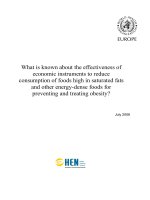What is life
Bạn đang xem bản rút gọn của tài liệu. Xem và tải ngay bản đầy đủ của tài liệu tại đây (4.17 MB, 42 trang )
Tardigrade
QuickTime™ and a
TIFF (Uncompressed) decompressor
are needed to see this picture.
Life
A Short
Summary
QuickTime™ and a
TIFF (Uncompressed) decompressor
are needed to see this picture.
Slime Mold
What is Life?
• Composed of organic compounds
• Resistance to entropy (disorder)
– Requires energy (must be able to gather and process
(metabolize) energy)
• Ability to maintain a controlled environment
– Requires ability to be isolated from environment
• Information storage
• Self replication
– Including ability to pass on information
• Ability to adapt to its environment
– Undergoes biological evolution
Life on Earth:
Organic Compounds
Important Elements
•Oxygen(O)
•Carbon (C)
•Hydrogen (H)
•Nitrogen (N)
•Phosphorous (P)
•Sulfur (S)
Human
Alfalfa Bacteria
62.8%
19.4%
9.3%
5.1%
0.6%
0.6%
77.9%
11.3%
8.7%
0.8%
0.7%
0.1%
Carbon is found in all organic compounds
73.7%
12.1%
9.9%
3.0%
0.6%
0.3%
Why Carbon?
• Small and Abundant
• 4th most abundant element in the Solar System
• Bonds with a lot of different atoms
• Forms lots of different organic compounds
• Forms long chains (polymers)
• Forms very strong bonds
• Hard to destroy (Stable)
• Bonds “store” a lot of energy
• Forms compounds that are
water soluble
Life on Earth:
Organic Compounds
Types of Organic Compounds
1. Lipids - (H,C (hydrocarbons))
Fats and Oils
cell membranes & energy storage
2. Carbohydrates - (C, H, O)
Sugars, Starches and Cellulose
energy storage & structure
Life on Earth:
Organic Compounds
Types of Organic Compounds
3. Amino Acids Proteins - (C, H, O, N, S)
Enzymes - catalysts for chemical reactions
also Hair, silk, fingernails, etc.
4. Nucleic Acids - (C, H, O, N, P)
DNA (Deoxyribonucleic Acid)
RNA (Ribonucleic Acid)
store & transfer genetic information
Organic Compounds
Not Alive
Cells
Organisms
Alive
Life on Earth:
Controlled Environment
Cell
Eukaryote
Prokaryote
Prokaryote - E. coli
• Small (<5µm)
• No nucleus
• Unicellular
Eukaryote
- Frog &
Ameba
• Larger (> 10 µm)
• Nucleus
• Organelles
• Cytoskeleton
• Uni- and multi-cellular
Life on Earth:
Controlling Entropy
Gathering Energy
Photosynthesis
Carbon Dioxide + Water + Sunlight --> Sugar + Oxygen
Chemosynthesis
Hydrogen Sulfide + Carbon Dioxide + Water + Oxygen
+ Geothermal Heat --> Sugar + Sulfuric Acid
Chloroplasts
Life on Earth:
Controlling Entropy
Releasing Energy
Respiration
Sugar + Oxygen --> Carbon Dioxide + Water + Energy
Mitochondria
Life on Earth:
Information
Storage
DNA - Deoxyribonucleic Acid
RNA - Ribonucleic Acid
Chromosomes
Human Chromosomes
Chromosome Numbers
Life on Earth:
Information
Storage
DNA - Deoxyribonucleic Acid
RNA - Ribonucleic Acid
Replication
DNA
Transcription
RNA
Translation
Protein
The Universal Genetic Code
AUG - UGC - CAU - AAA - UGA
Start - Cysteine - Histidine - Lysine - Stop
DNA Translation
Instructions: How to make proteins from amino acids
Genetics Produce Variety
Life on
Earth:
Self
Replication









